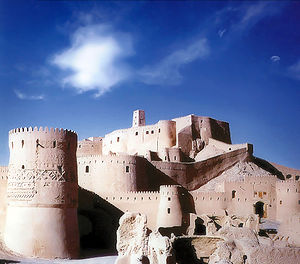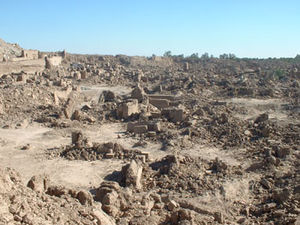- Arg-é Bam
-
Coordinates: 29°07′00.68″N 58°22′06.51″E / 29.1168556°N 58.368475°E
The Arg-é Bam (ارگ بم in Persian, "Bam citadel") was the largest adobe building in the world, located in Bam, a city in the Kermān Province of southeastern Iran. It is listed by UNESCO as part of the World Heritage Site "Bam and its Cultural Landscape". This enormous citadel on the Silk Road was built before 500 BC and remained in use until 1850 AD. It is not known for certain why it was then abandoned.
The entire building was a large fortress in whose heart the citadel itself was located, but because of the impressive look of the citadel, which forms the highest point, the entire fortress is named the Bam Citadel.
On December 26, 2003, the Citadel was almost completely destroyed by an earthquake, along with much of the rest of Bam and its environs. A few days after the earthquake, the then Iranian President Mohammad Khatami announced that the Citadel would be rebuilt.
Contents
Dimensions
Larger than nearby Arg-é Rayen, the area of Bam Citadel is approximately 180,000 square meters, and it is surrounded by gigantic walls 6-7 metres high and 1815 metres long. The citadel features two of the "stay-awake towers" for which Bam is famed - there are as many as 67 such towers scattered across the ancient city of Bam.
Citadel design and architecture
The planning and architecture of the citadel are thought out from different points of view. From the present form of the citadel one can see that the planner(s) had foreseen the entire final form of the building and city from the first steps in the planning process. During each phase of building development the already-built part enjoyed a complete figure, and each additional part could be "sewn" into the existing section seamlessly.
The citadel is situated in the center of the fortress-city, on the point with widest view for security.
In the architectural form of Bam Citadel there are two different distinguishable parts:
- The rulers' part in the most internal wall, holding the citadel, barracks, mill, 4-sezonan house, water-well (dug in the rocky earth and about 40 metres deep), and a stable for 200 horses.
- The ruled-over part surrounding the rulers' place, consisting of the main entrance of the entire fortress-city and the bazaar alongside of the North-to-South spinal axis (which connects the main entrance to the citadel), and around 400 houses with their associated public buildings (such as a school and sport place).
Among the houses, three different types are recognizable:
- Smaller houses with 2-3 rooms for the poor families.
- Bigger houses with 3-4 rooms for the middle social class, some of which have also a veranda.
- The most luxurious houses with more rooms oriented in different directions suitable for different seasons of the year, together with a big court and a stable for animals nearby. There are few of this type of houses in the fortress.
All buildings are made of non-baked clay bricks, i.e. adobes. Bam Citadel was probably, prior to the 2003 earthquake, the biggest adobe structure in the world.
The Citadel was used as the major location site for Valerio Zurlini's film of The Desert of the Tartars.
Security
When the gate of the city was closed, no human or animal could enter. The inhabitants could continue living for a long period of time in isolation as they had access to a well, gardens, and domestic animals inside. When the fortress-city was besieged the inhabitants could remain in the city while the soldiers could defend it, protected by high walls and towers.
Air conditioning
Besides the watch towers and ornamented tops of the high walls on the skyline of the fortress, the wind-catchers or wind-towers (in Persian: badgir بادگير) are remarkable. They are structures protruding from the buildings to catch the wind and direct it into the buildings. Sometimes the air is passed over a water basin in the building to cool it and remove dust. Different types of wind towers are utilized for different buildings. For example there are 4-directional wind-towers for larger and more important buildings, which are able to catch the wind from different directions, and there are one directional wind towers for smaller buildings.
2003 Earthquake
Main article: 2003 Bam earthquakeThe 2003 Earthquake in Bam destroyed more than 80 percent of the Citadel. As a World Heritage site several countries are cooperating in the reconstruction. Japan, Italy, and France are among countries which cooperated from the beginning. Japan has granted some US$1.3 million to Iran for the reconstruction, and has supported this project by sending equipment and creating the 3D plan of Bam Citadel to increase the accuracy of the renovation. Italy has funded US$300,000 in the salvation project, and has dispatched a team of experts to restore the main tower of Bam. France has helped Iran by providing the map of Bam Citadel. World Bank has also granted a large sum of money to this project.
See also
- List of Iranian castles
- Iranian architecture
References
The original text was a translation by of the article "Bam-Citadelo", originally written in Esperanto language by Asad Mahbub, first appeared in Irana Esperantisto (Iranian Esperantist), No. 4, Year 2, Summer 2003, 40 p., pp. 5-7. Permission has been granted for its use in Wikipedia. Its sources were:
- Nimrokhi az Arge Bam (Bam Citadel at a Glance), by Davood Yousofzadeh, Bam: M. Mohammadi-zade, 1998, p160
External links
- Bam and its Cultural Landscape (World Heritage List)
- Bam Citadel site, with photos
- The Bam Citadel / ARGE BAM - *** MOVIE DOCUMENTARY in English
- Newspaper item: "The Lost Beauty that was Bam"
- Photos of the Bam Citadel
- More photos of the citadel
- Iran Cultural Heritage Organisation Site on Arge Bam
- Iran Cultural Heritage Organisation Site - Reconstruction Photos
Categories:- Castles in Iran
- World Heritage Sites in Iran
- Iranian architecture
- 6th-century BC architecture
- Visitor attractions of Bam
Wikimedia Foundation. 2010.



